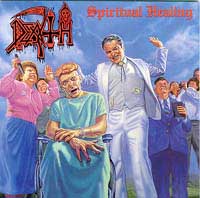Review: Foundational death metal progenitor Death isolates the core of the death metal experience through simple music which despite its seeming randomness and inexpert, angry, thrashing demonstrates a core of central ideas, blasting under heavy preaching of the violent justice and chaos of nature. It both reveals the limitations of its world and the limitations of the artists, who seem almost suspended in the collection of alienated ideas that cycle through the aesthetic supporting this work.
Death's riffs hold together on the personality of their phrasing, through either simple variations in rhythm or the declarative, inexorable feel to their structure which leads one to worship the resolution as Leviathan, the center and the connecting way. Such is the dark underside of Death: built from simple pieces of barr chord or power chord scales, it is a sequence of riffs hammered into place with enough adjustments to hold the piece together compositionally as well as a rewarding frequency of memorable connective instances where the compositional conception of Death comes together as language in exemplary demonstration.
Tracklist:
1. Living Monstrosity (5:06)
2. Altering the Future (5:33)
3. Defensive Personalities (4:42)
4. Within the Mind (5:33)
5. Spiritual Healing (7:43)
6. Low Life (5:21)
7. Genetic Reconstruction (4:50)
8. Killing Spree (4:13)
Length: 43:22
|

Copyright © 1990 Combat/Relativity
|
Like most metal bands, this music exists in maturity beyond its years as regards its crazily structural and obsessively meticulous counterpoint alignments; in phrasing alone, it distinguishes itself as both method and personality, as well as signifying its artistic statement of nihilism and frustration. Schuldiner and bassist Terry Butler put together lengthy, violent songs with the evident power that something like execution would have upon the listener; Bill Andrews on drums puts down jazzier Lombardo structures of internal opposition, and rides mechanical fills to great effect while Rick Rozz (of later Massacre fame) grinds alongside Schuldiner's simple but effective riffs.
This metal inspired a generation of death metal bands for its power in opening a future, that of a style using a different method of more complex structure than speed metal, which had run into the wall of its own entrenchment in conventional technicality. Death chose hardcore simplicity and melodramatic, Venom-esque demonstrative music but twisted it into something more relevant, music which encompassed the changing mood of generations and minds: from the hippie rationalism of speed metal to the nihilistic violence of death metal and its lurking darker cousin, black metal.
The music evolving in this simple style took the definitive nature of hardcore and used it to emphasize the inexorable before the ineffable, demonstrating mortality and brutal, judgemental interpretations of reality.
Its obsession with cruelty, violence, and hatred might make it an easy target for some, but Death have their finger on a crucial point in modern society: if these things are evil, why are they logic in our world? Schuldiner's often-preachy embrace of different values and their counterpoints provides more of an example than anything else, of how frustrating the furious meaninglessness of modern society can be.
James Murphy (of DISINCARNATE, OBITUARY, CANCER, TESTAMENT) provides immense lead guitar trading off with the more abstract and seemingly random but still vivid, almost visual psychedelia of violence coming from Schuldiner's guitar. Murphy's re-enactment of guitar solos innovations through death metal stylings creates atmosphere and precision vocalization throughout these circuitous songs.
This album innovates many of the styles of death metal: cyclonic strumming that synchs to micro-reductive rhythms, churning like an underground music; the placement of muffled strumming between verses for Baphomet-style riding brutality; ambient rolling tonal shifts subtly altering harmonic space behind lead guitars or lead rhythms of fast, liquid notes; backgrounding of major notes into the riff to achieve subtle but effective double-strumming; and synchronizing of strumming rhythm with percussion high register (high hat or similar distinctive low-footprint sounds). In these, and in the basic and undefinable art of phrase/virus composition, Death are supreme.
